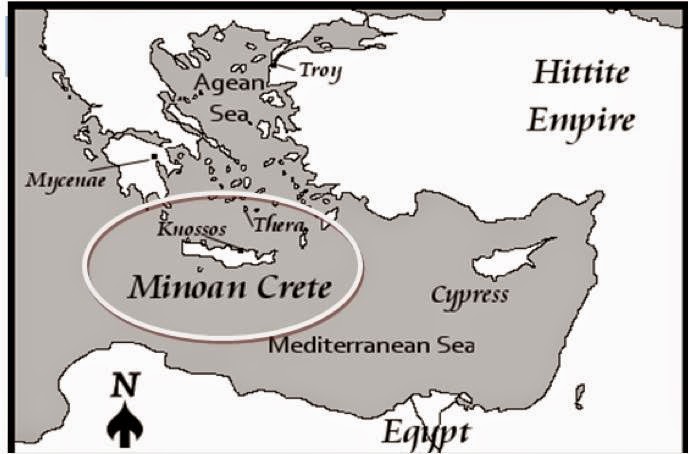MINOAN/CRETE CULTURE
It’s named after the king Minos, who was a prehistoric
king of Crete.
They are 3 periods we can divide de Minoan culture:
· Early
Minoans 2900-2000 B.C.
· Middle
Minoan 2000- 1550 B.C.
· Late Minoan
1550-1200 B.C.
Location
Historical Background
Lifestyle
Minoans were aware and utilized the art of metalworking.
The first written scripts of the Minoans resemble
egyptian hieroglyphs
Religion
Minoans deified the natural world and found in it a logical order that allowed man to live in harmony with the natural environment.
Ritual
celebrations usually took place in sacred caves, on sanctuaries on mountain
peaks, and in the palaces and villas which all had their own sanctuaries.
Animal and bloodless sacrifices, along with processions were part of ritual worship
of the great female nature goddess, and during these festivities worshipers
used music, dance, and prayer to achieve a state of religious ecstasy that put
them in touch with the supernatural.
Products
The products made by the Minoans revolved around the
religious cult. There have been found many artifacts used for sacrifice in what
are supposed to the sanctuaries of the Minoan culture. They made metal made
jewelry that was probably exported around the Mediterranean. There have also
been found pottery products with symmetrical shapes. The characteristic
elegance of form of Minoan potter is complemented by the dynamic lines of
naturalistic scenes that decorate the surfaces. In general all of the art found
reflects the philosophical attitude present at the time.
Government
Thanks to the art found in the palaces we can deduct that
they were independent, and the palace was the center of the administrative
power. Some kind of federal organization may have existed. The luxury in the
palaces and houses allow us to think that there was a king and an aristocracy.
Cultural background
The language they spoke in Crete is not known yet. Though
sir Arthur Evans ( the fist man to study in detail Crete) claimed that the
Minoans’ ancestors came from North Africa, but more recent studies have carried
out DNA tests from Minoan osseous tissue and it suggest that the civilization
was composed of local Europeans rather than outsiders. Therefore Minoan people
may be related to groups that migrated from Anatolia. If this information is
true the researchers will have more cues to decipher the language of the Minoan
civilization.
Minoan art
Characteristics: The art of the minoans speak of a society of joyous disposition, in touch with their environment, and in awe of the logical order of the natural world. Above all, the unearthed artifacts reveal a people who had developed a high degree of self-respect and a keen eye for observing and adopting to their physical environment.
Examples:
References:
http://www.ancient-greece.org/art/minoan-art.html






No hay comentarios:
Publicar un comentario